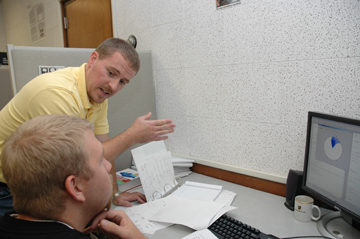Radio Frequency Study Holds Key to Groundbreaking Brain Research

Researchers from the University of Kansas are using a mathematical tool in a new way that could have important implications in the treatment of those with epilepsy.
Originally, the mathematical algorithm known as SAFFIRE (Source Affine Image Reconstruction) was designed to pinpoint the location of radio frequency signals. But researchers from the KU School of Engineering and the Hoglund Brain Imaging Center at the KU Medical Center are using those same equations to analyze data of the brain in groundbreaking ways.
The research improves how data from Magnetoencephalography, known as MEG, is interpreted. MEG measures the infinitesimal magnetic fields generated by brain activity. The readings of those fields then are used to detect abnormalities in brain function and to assist researchers in identifying how various parts of the brain work.
The MEG innovation is built upon research funded by a $330,000 Department of Defense grant designed to help the U.S. Navy improve radar sensitivity. In the course of the research, a team led by Shannon Blunt, assistant professor of electrical engineering and computer science, worked to define the precise location of a specific RF signal.
“As we looked into this, we developed a mathematical structure to solve the problem, and it worked really well,” Blunt said.
A colleague introduced Blunt to Mihai Popescu, a research assistant professor with the Department of Molecular and Integrative Physiology at the Hoglund Brain Imaging Center, since both were working on signal processing problems. Their conversation turned to the problems with interpreting data from MEG.
“The drawback with MEG to date is that there are not generally good ways of taking the data collected and generating that resulting image of brain activity,” Blunt said. “It’s a really hard problem to solve. We actually took the approach that we had used for RF sensors and tried it out. We had to alter it some, but we ended up with an approach that worked well on real MEG data.”
Apart from assisting research studies, the new method of reading MEG data could help in the treatment of those with epilepsy. About 30 percent of epilepsy patients don’t respond well to medication.
“When that happens, the doctor might opt for surgery to work on areas that trigger the seizures,” said Popescu. “So the patient can have an MEG test at the Hoglund Brain Imaging Center, where we record brain signals for 30 to 60 minutes. We analyze the MEG data and identify those brain areas responsible for seizures.”
The information is key in pre-surgical planning and can help doctors avoid a more invasive technique to confirm the data revealed through the algorithm, Popescu said.
The algorithm has been tested on data from previous studies but has not yet moved on to clinical trials with patients. In the meantime, Blunt and Popescu continue to work to unlock the mysteries around the process.
“Our solution depends on the presumed knowledge that we have a ‘perfect’ electromagnetic spatial model of the head,” Blunt said. “However, this perfect knowledge is impossible in reality. So the next step is to compensate for our ignorance. We have an approach that does this now, which is why the SAFFIRE algorithm works at all on real data, but that doesn’t mean we can’t do better.”
The SAFFIRE approach is patent pending.